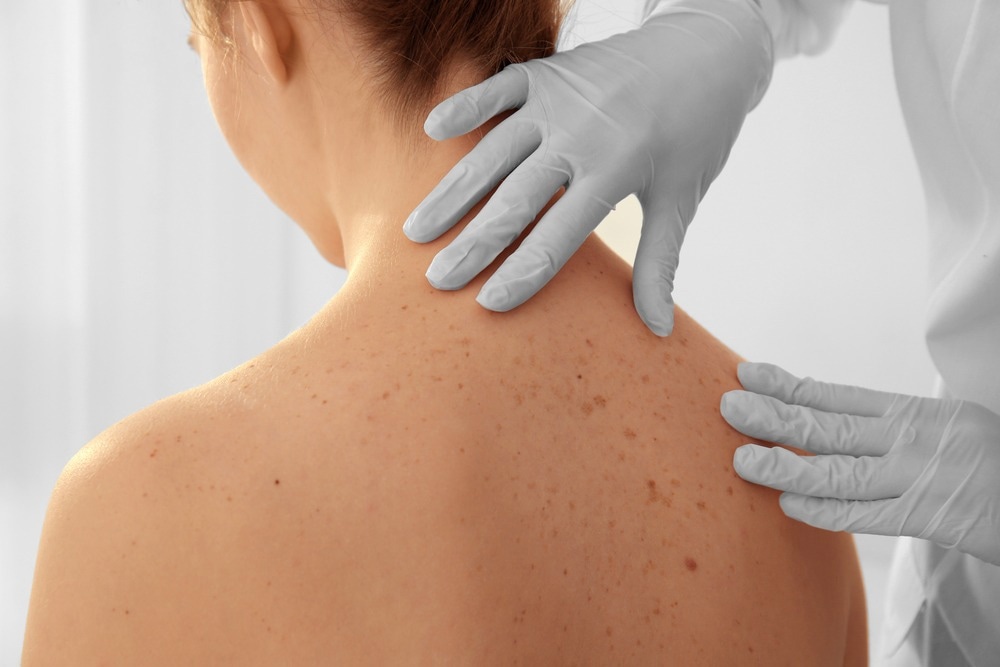In a recent study published in The Journal of Physical Chemistry C, researchers demonstrated an approach to detect tyrosinase (TYR) activity, an important biomarker for melanoma diagnosis, with the aid of an unprecedented transportable surface-enhanced Raman scattering biosensor.

Study: Surface-Enhanced Raman Scattering Biosensor Based on Self-Assembled Gold Nanorod Arrays for Rapid and Sensitive Detection of Tyrosinase. Image Credit: Africa Studio/Shutterstock.com
The surface-enhanced Raman scattering biosensor, fabricated on a glass chip, is developed on dopamine (DA)-operationalized Au nanorod (Au NR) arrays serving as the capture substrate and 4-mercaptophenylboronic acid (4-MPBA)-altered silver nanoparticles (Ag NPs) forming the surface-enhanced Raman scattering biosensor probe. Since detecting TYR activity in biological samples is crucial for clinical melanoma diagnosis, the proposed approach with various advantages of sensitivity, portability, and reproducibility can be beneficial for melanoma diagnosis.
Tyrosinase and its Role in Melanin Synthesis
Tyrosinase, a type III dinuclear copper-containing metalloenzyme, plays a vital role in the biosynthesis of melanin. As a result, its inhibition can prevent the development of several skin disorders. Also, this human enzyme characteristic of melanogenesis shows thorough catalytic enzyme activity in vivo and catalyzes the hydroxylation of L-3,4-dihydroxyphenylalanine and oxidation of dopamine (DA) into dopaquinone (DQ). Consequently, aberrant TYR expression can cause skin conditions such as melasma, vitiligo, and the most lethal manifestation of skin cancer, melanoma.
Since TYR is a pivotal biomarker for melanoma diagnosis, various methods, including the electrochemical technique, colorimetric method, high-performance liquid chromatography, and fluorescence, have been tried and tested to detect TYR in biological samples to date.
The inherent limitations of these techniques, such as relatively low sensitivity, susceptibility to interference, and exorbitant equipment, make the surface-enhanced Raman scattering biosensor an extremely desirable alternative approach.
Surface-enhanced Raman scattering biosensors use a powerful non-destructive, ultrasensitive detection technique that uses the molecular interaction among molecules adsorbed on nanometallic planes and the electromagnetic field present in the resonance region.
The present study developed a portable surface-enhanced Raman scattering biosensor to detect TYR activity synthesized on the Au NR arrays. The effective detection of the TYR activity results in a successful melanoma diagnosis.
Au NRs and their Preparation
To achieve a significant nanorod yield, excellent uniformity, and the least quantity of impurities, the Au NRs were prepared using a more advanced method. Initially, 0.025 mL of a 10 mM HAuCl4 solution and 0.1 M CTAB having a volume 1 mL were combined to create a seed solution. After 30 minutes of stirring, 0.8 mL of freshly produced NaBH4 at 10 mM was added to the mixture.
The generated seed solution was untouched at 30 ⁰C for two hours. A total of 7 g of CTAB and 1.234 g of NaOL were mixed in 250 mL of H2O at 50 ⁰C to produce the growth solution. 18 mL of a 4 mM AgNO3 solution was added when the solution cooled to 30 ⁰C under constant stirring.
After adding 250 mL of 1 mM HAuCl4 and 90 minutes of stirring, the solution progressively turned from orange to colorless. After stirring for 15 minutes, 2.1 mL of a 37 ⁰C HCl solution was added. The growth solution mentioned above was mixed for 30 seconds with 64 mM AA with a volume of 1.25 mL before being injected with 0.8 mL of gold seed mixture, which was then left to stand for 48 hours at 30 °C.
The transfer and compression at three-phase interfaces driven by the Marangoni reaction formed the foundation for synthesizing the Au NR arrays.
The successful synthesis of the Ag NPs was achieved using the Lee and Meisel method, which included the reduction of AgNO3 by citrate in an aqueous phase.
Detection of TYR in the Serum Sample
The serum samples were centrifuged before analysis at 1000 rpm for 10 minutes to collect the supernatant and reduce the other substances that would impede the detection of the TYR in the sample, thereby interfering in the successful melanoma diagnosis.
A Raman spectrometer with 785 nm excitation, 50X objective lens, and an exposure time of 10 s was then used to derive the Raman spectra.
The TYR solution was mixed with various concentrations of inhibitors and incubated for 15 min at 37 ⁰C to achieve inhibition. Later, the surface-enhanced Raman scattering measurements were performed on this inhibitor-treated TYR solution by introducing the surface-enhanced Raman scattering biosensor.
Novel Biosensor Effectively Detects TYR Activity
The experimental findings of the present work revealed that the recoveries were in the 96.85-98.74% range when known amounts of various concentrations of TYR were added to the serum.
The method under study was further applied to screen TYR inhibitors, and an inversely proportional relation was determined where an increase in the inhibitor concentrator resulted in a weaker TYR activity.
These results indicated that the surface-enhanced Raman scattering biosensor can be used for the quantitative analysis of TYR activity, an important biomarker for melanoma diagnosis, and screening of TYR inhibitors.
Conclusion
The state-of-the-art portable surface-enhanced Raman scattering biosensor presented in the current work is fabricated on a glass chip and is based on Au NR arrays.
This novel approach for detecting TYR activity in biological samples necessary for preclinical melanoma diagnosis has a competitive edge over its precursors due to its several advantages, including sensitivity, portability, and reproducibility.
This technique has a broad linear detection range that can effectively assess 0.0001 U/mL of TYR activity without any complex nanofabrication. The proposed method also eliminates the accumulation of nanoparticles and is convenient in structure, making it a preferred choice for melanoma diagnosis.
References
Minling Li et al. (2022) Surface-Enhanced Raman Scattering Biosensor Based on Self-Assembled Gold Nanorod Arrays for Rapid and Sensitive Detection of Tyrosinase. The Journal of Physical Chemistry C. https://pubs.acs.org/doi/10.1021/acs.jpcc.2c03408
Disclaimer: The views expressed here are those of the author expressed in their private capacity and do not necessarily represent the views of AZoM.com Limited T/A AZoNetwork the owner and operator of this website. This disclaimer forms part of the Terms and conditions of use of this website.